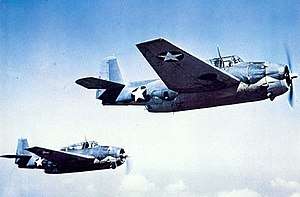Grumman
The Grumman Aircraft Engineering Corporation, later Grumman Aerospace Corporation, was a leading 20th century American producer of military and civilian aircraft. Founded on December 6, 1929, by Leroy Grumman and partners, it merged in 1994 with Northrop Corporation to form Northrop Grumman.
 | |
| Industry | Aircraft; aircraft parts and equipment; data processing and preparation; search and navigation equipment; truck and bus bodies; electrical equipment and supplies |
|---|---|
| Fate | Merged with Northrop |
| Successor | Northrop Grumman |
| Founded | 1929 |
| Founders | |
| Defunct | 1994 |
| Headquarters | |
Key people | |
| Products | |
Number of employees | 23,000 (1986) |
| Subsidiaries |
|
History
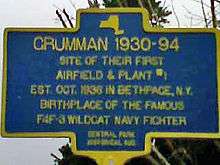
Leroy Grumman worked for the Loening Aircraft Engineering Corporation beginning in 1920, and when it was bought by Keystone Aircraft Corporation and the operations were moved from New York City to Bristol, Pennsylvania in 1929 Grumman and his partners, all ex-Leoning Aircraft employees [1], (Edmund Ward Poor,[2] William Schwendler, Jake Swirbul, and Clint Towl) started their own company in an old Cox-Klemin Aircraft Co. factory in Baldwin on Long Island, New York.
The company registered as a business on December 5, 1929, and officially opened on January 2, 1930. While maintaining the business by welding aluminum tubing for truck frames, the company eagerly pursued contracts with the US Navy.[1] Grumman designed the first practical floats with a retractable landing gear for the Navy, and this launched Grumman into the aviation market.[1] The first Grumman aircraft was also for the Navy, the Grumman FF-1, a biplane with retractable landing gear.[1] This was followed by a number of other successful designs.[1]
During World War II, Grumman became known for its "Cats", Navy fighter aircraft, F4F Wildcat and F6F Hellcat, the less well known Grumman F7F Tigercat and Grumman F8F Bearcat,[3] and for its torpedo bomber TBF Avenger.[4] Grumman ranked 22nd among United States corporations in the value of wartime production contracts.[5] Grumman's first jet aircraft was the F9F Panther; it was followed by the upgraded F9F/F-9 Cougar, and the less well known F-11 Tiger in the 1950s. The company's big postwar successes came in the 1960s with the A-6 Intruder and E-2 Hawkeye and in the 1970s with the Grumman EA-6B Prowler and F-14 Tomcat. Grumman products were prominent in several feature movies including The Final Countdown in 1980[6] and Top Gun in 1986.[7] The U.S. Navy still employs the Hawkeye as part of Carrier Air Wings on board aircraft carriers, while the U.S. Marine Corps, the last branch of service to fly the Prowler retired it on March 8, 2019.[8]
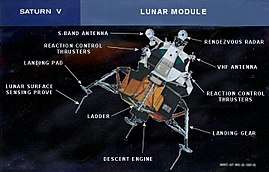
Grumman was the chief contractor on the Apollo Lunar Module that landed men on the moon.[9] The firm received the contract on November 7, 1962, and built 13 lunar modules; 6 out of those lunar models landed on the moon. The last lunar module was given permanently to the Smithsonian Institution.[10] As the Apollo program neared its end, Grumman was one of the main competitors for the contract to design and build the Space Shuttle but lost to Rockwell International.[11]
In 1969 the company changed its name to Grumman Aerospace Corporation,[12] and in 1978 it sold the Grumman-American Division to Gulfstream Aerospace.[13] That same year, it acquired the bus manufacturer Flxible. The company built the Grumman Long Life Vehicle (LLV), a light transport mail truck designed for and used by the United States Postal Service. The mail truck had been built from 1987 until 1994. Originally, it was supposed to stay in usage for 24 years, although, some of them are still in service today.[14] In December 1982, Grumman announced that they will be selling Flxible for $40 million to the General Automotive Corporation of Ann Arbor.[15]
Grumman was responsible for a successful line of business aircraft including the Gulfstream I turboprop (Grumman model G-159) and Gulfstream II business jet (Grumman model G-1159) which were operated by a number of companies and private individuals as well as by government agencies including various military entities and NASA. In addition, the Gulfstream I propjet was operated by several commuters/regional airlines in scheduled passenger services and included a stretched version, being the Gulfstream I-C (Grumman model G-159C) which could transport 37 passengers. Gulfstream business jets continue to be currently manufactured by Gulfstream Aerospace, which is a wholly owned subsidiary of General Dynamics.[16]
Long Island location


For much of the Cold War period, Grumman was the largest corporate employer on Long Island.[17] Grumman's products were considered so reliable and ruggedly built that the company was often referred to as the "Grumman Iron Works".[18]
As the company grew, it moved to Valley Stream, New York, then Farmingdale, New York, finally to Bethpage, New York, with the testing and final assembly at the 6,000-acre (24 km2) Naval Weapons Station in Calverton, New York, all located on Long Island. At its peak in 1986 it employed 23,000 people on Long Island[19] and occupied 6,000,000 square feet (560,000 m2) in structures on 105 acres (0.42 km2) it leased from the U.S. Navy in Bethpage.[20]
The end of the Cold War at the beginning of the 1990s reduced defense spending and led to a wave of mergers as aerospace companies shrank in number; in 1994 Northrop bought Grumman for $2.1 billion to form Northrop Grumman,[20] after Northrop topped a $1.9 billion offer from Martin Marietta.[21]
The new company closed almost all of its facilities on Long Island and converted the Bethpage plant to a residential and office complex, with its headquarters becoming the corporate headquarters for Cablevision and the Calverton plant being turned into a business/industrial complex. Former aircraft hangars have become Grumman Studios, a film and television production center. A portion of the airport property has been used for the Grumman Memorial Park.[7]
Products
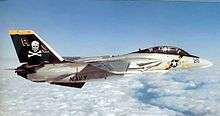
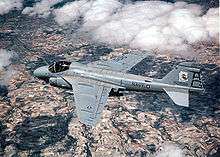



Aircraft
| Model name | First flight | Number built | Type |
|---|---|---|---|
| Grumman FF | 1931 | 116 | Single piston engine naval fighter |
| Grumman JF Duck | 1933 | 48 | Single piston engine floatplane observation airplane |
| Grumman F2F | 1933 | 55 | Single piston engine naval fighter |
| Grumman F3F | 1935 | 147 | Single piston engine naval fighter |
| Grumman XSBF | 1936 | 1 | Prototype single piston engine dive bomber |
| Grumman J2F Duck | 1936 | 254 | Single piston engine floatplane observation airplane |
| Grumman G-21 Goose | 1937 | 345 | Twin piston engine flying boat |
| Grumman F4F Wildcat | 1937 | 2,605 | Single piston engine naval fighter |
| Grumman G-44 Widgeon | 1940 | 276 | Twin piston engine flying boat |
| Grumman XF5F Skyrocket | 1940 | 1 | Prototype twin piston engine naval fighter |
| Grumman XP-50 | 1941 | 1 | Prototype twin piston engine fighter |
| Grumman TBF Avenger | 1941 | 2,290 | Single piston engine torpedo bomber |
| Grumman F6F Hellcat | 1942 | 12,275 | Single piston engine naval fighter |
| Grumman F7F Tigercat | 1943 | 364 | Twin piston engine naval fighter |
| Grumman Kitten | 1944 | 2 | Prototype single piston engine airplane |
| Grumman F8F Bearcat | 1944 | 1,265 | Single piston engine naval fighter |
| Grumman G-65 Tadpole | 1944 | 1 | Prototype single piston engine flying boat |
| Grumman AF Guardian | 1945 | 389 | Single piston engine anti-submarine warfare airplane |
| Grumman G-73 Mallard | 1946 | 59 | Twin piston engine flying boat |
| Grumman HU-16 Albatross | 1947 | 466 | Twin piston engine flying boat |
| Grumman F9F Panther | 1947 | 1,382 | Single jet engine naval fighter |
| Grumman F9F-6 Cougar | 1951 | 1,988 | Single jet engine naval fighter |
| Grumman XF10F Jaguar | 1952 | 1 | Prototype single jet engine naval fighter |
| Grumman S-2 Tracker | 1952 | 1184 or 1185 | Twin piston engine anti-submarine warfare airplane |
| Grumman F11F Tiger | 1954 | 200 | Single jet engine naval fighter |
| Grumman C-1 Trader | 1955 | 87 | Twin piston engine cargo airplane |
| Grumman F11F-1F Super Tiger | 1956 | 1 | Prototype single jet engine naval fighter |
| Grumman E-1 Tracer | 1956 | 88 | Twin piston engine airborne early warning airplane |
| Grumman Ag Cat | 1957 | Single piston engine agricultural airplane | |
| Grumman Gulfstream I | 1958 | 200 | Twin turboprop engine business airplane |
| Grumman OV-1 Mohawk | 1959 | 380 | Twin turboprop engine observation airplane |
| Grumman A-6 Intruder | 1960 | 693 | Twin jet engine attack airplane |
| Grumman E-2 Hawkeye | 1960 | 122 | Twin turboprop engine airborne early warning airplane |
| Grumman C-2 Greyhound | 1964 | 56 | Twin turboprop engine cargo airplane |
| General Dynamics–Grumman F-111B | 1965 | 7 | Prototype twin jet engine naval fighter |
| Grumman Gulfstream II | 1966 | 256 | Twin jet engine business airplane |
| Grumman EA-6B Prowler | 1968 | 170 | Twin jet engine electronic warfare airplane |
| Grumman F-14 Tomcat | 1970 | 712 | Twin jet engine naval fighter |
| Grumman American GA-7 Cougar | 1974 | ~1[lower-alpha 1] | Twin piston engine civil airplane |
| General Dynamics–Grumman EF-111A Raven | 1977 | 42 | Twin jet engine electronic warfare airplane |
| Grumman X-29 | 1984 | 2 | Experimental single jet engine airplane |
| Grumman XJL | N/A | 0[lower-alpha 2] | Single piston engine floatplane observation airplane |
| Grumman American AA-1 | Single piston engine civil airplane | ||
| Grumman American AA-5 | Single piston engine civil airplane | ||
Projects
- Grumman 674 Nutcracker tilting fuselage VTOL
- Grumman 698 VTOL
- Grumman G-3 project only
- Grumman G-4 project only
- Grumman G-17 project only
- Grumman G-25 project only
- Grumman G-27 project only
- Grumman G-29 project only
- Grumman G-30 project only
- Grumman G-35 project only
- Grumman G-48 project only
- Grumman G-49 project only
- Grumman G-57 project only
- Grumman G-62 project only
- Grumman G-68 project only
- Grumman G-71 project only
- Grumman G-76 project only
- Grumman G-77 swept-back wing research aircraft project
- Grumman G-78 towed target glider project
- Grumman G-84 project only
- Grumman G-85 project only
- Grumman G-86 project only
- Grumman G-91 project only
- Grumman G-92 project only
- Grumman G-97 project only
- Grumman G-107 project only
- Grumman G-108 project only
- Grumman G-110 project only
- Grumman G-113 project only
- Grumman G-114
- Grumman G-115
- Grumman G-116 project only
- Grumman G-118 project only
- Grumman G-119 project only
- Grumman G-122 project only
- Grumman G-124 jet trainer design
- Grumman G-127
- Grumman XTB2F
- Grumman XTSF
Spacecraft
- Space
- Apollo Lunar Module
- Grumman 619 Space Shuttle
Other products
- Grumman manufactured fire engines under the name Firecat and aerial tower trucks under the Aerialcat name. The company entered the fire apparatus business in 1976 with its purchase of Howe Fire Apparatus.[22]
- Grumman canoes were developed in 1944 as World War II was winding down. Company executive William Hoffman used the company's aircraft aluminum to replace the traditional wood design. The canoes had a reputation for being sturdier, lighter and stronger than their wood counterparts and had a considerable market share. Grumman moved its boat making division to Marathon, New York in 1952.
- Outboard Marine Corp. bought the division in 1990 and produced the last Grumman-brand canoe in 1996. Shortly thereafter former Grumman executives formed the Marathon Boat Group to produce the canoes. In 2000 the Group worked out an agreement with Northrop Grumman to sell the canoes using Grumman name and logo.[23][24]
- Grumman sport boat[25]
- Grumman-Flxible 870 transit buses (1978–1982)[26]
- Ben Franklin (PX-15), a science submarine[27]
- Grumman LLV postal vehicle widely used by the United States Postal Service[7] and Canada Post[28]
- In honor of Grumman's aviation and aerospace inventions, a Grumman Memorial Park was established in Calverton, New York.[7]
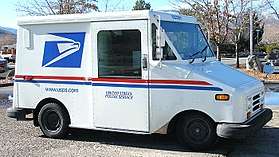


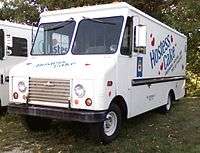
References
Notes
- Jordan, Corey C. "Grumman's Ascendency: Chapter One." Archived November 3, 2013, at the Wayback Machine Planes and Pilots Of World War 2, 2000. Retrieved: July 22, 2011.
- "Air Warfare". An International Encyclopedia, Volume Two, M-Z, Volume 1, pp. 270–271.
- Nicklas, Brian (September 2006). "The Grumman Cats". Air Space Magazine. Retrieved April 19, 2020.
- "Grumman TBM Avenger". Pearl Harbor Aviation Museum. Retrieved April 19, 2020.
- Peck, Merton J. & Scherer, Frederic M. The Weapons Acquisition Process: An Economic Analysis (1962) Harvard Business School p.619
- Stephen A. Riffin (June 1, 2005). Aviation's Most Wanted: The Top 10 Book of Winged Wonders, Lucky Landings, and Other Aerial Oddities. p. 339. Retrieved April 18, 2020.
- Ian I. Stark (March 29, 2018). "Grumman Studios: Secrets and fun facts". Newsday. Retrieved April 17, 2020.
- "EA-6B Prowler, one of the saltiest warfighters in the Marine Corps, retires", "MarineTimes"
- "Apollo Spacecraft: News Reference" (PDF). NASA. Retrieved April 16, 2020.
- "Lunar Module". Cradle of Aviation Museum. Retrieved April 16, 2020.
- Astronautics and Aeronautics: Chronology of Science, Technology, and Policy. 1972. p. 339. Retrieved April 16, 2020.
- "Grumman Aerospace Corporation | American Company". Encyclopædia Britannica. Retrieved April 16, 2020.
- Thomas, Joel (May 19, 2014). "History of Gulfstream Aerospace Corporation". Retrieved January 5, 2016.
- Gastelu, Gary. "$6.3 billion delivery: New U.S. Postal Service truck to be picked this year". Fox News. Retrieved April 16, 2020.
- "Grumman to Sell Troubled Bus Unit". The New York Times. December 22, 1982. Retrieved April 16, 2020.
- "Gulfstream News - History". Gulfstream News. Retrieved April 16, 2020.
- "Facts You Didn't Know About Long Island Businesses". Newsday. Newsday. Retrieved January 28, 2019.
- Skrula and Gregory 2004
- "Long Islanders Shocked by Grumman's Merger." The New York Times, March 8, 1994.
- "Commercial Property/Selling Off Northrop Grumman's Surplus; Cablevision Takes Last of the Grumman Buildings." The New York Times, December 28, 1997.
- "Northrop Bests Martin Marietta to Buy Grumman." The New York Times, April 5, 1994.
- Library, Beth OljaceAnderson Public. "Howe Fire Apparatus had know-Howe". Herald Bulletin. Retrieved March 9, 2019.
- "Paddling a Canoe to Success." Newsday. Retrieved: May 15, 2009.
- "Marathon BoatGroup: About Us." Marathonboat.com. Retrieved: May 15, 2009.
- "Marathon Boat Group - Sportboat". Marathon Boat. Retrieved April 17, 2020.
- "History - Flxible Owners International". Flxible Owners International. Retrieved April 17, 2020.
- "Deep Sea Sub Story". NASA. July 16, 2004. Retrieved April 17, 2020.
- Stu Mills (July 12, 2017). "Aging delivery trucks poisoning us, postal workers claim". CBC Canada. Retrieved April 17, 2020.
- Although a Grumman American design, most aircraft were built by Gulfstream American.
- Although a Grumman design, all three aircraft were built by Columbia.
Bibliography
- Ferguson, Robert G. "One Thousand Planes a Day: Ford, Grumman, General Motors and the Arsenal of Democracy." History and Technology, Volume 21, Issue 2, 2005.
- Fetherston, Drew. "Pioneers on the Runway: Raising Grumman." LI History.com, Grumman Park. Retrieved: March 18, 2009.
- Kessler, Pamela. "Leroy Grumman, Sky King." The Washington Post (Weekend), October 11, 1985.
- O'Leary, Michael, ed. "Leroy Grumman." Air Classics, Volume 19, no. 2, February 1983, pp. 27–29.
- Skurla, George M. and William H. Gregory. Inside the Iron Works: How Grumman's Glory Days Faded. Annapolis, Maryland: Naval Institute Press, 2004. ISBN 978-1-55750-329-9.
- Tillman, Barrett. Hellcat: The F6F in World War II. Annapolis, Maryland: Naval Institute Press, 2001. ISBN 0-87021-265-6.
- Thruelsen, Richard. The Grumman Story. New York: Praeger Publishers, Inc., 1976. ISBN 0-275-54260-2.
- Treadwell, Terry. Ironworks: Grumman's Fighting Aeroplanes. Shrewsbury, UK: Airlife Publishers, 1990. ISBN 1-85310-070-6.
External links
| Wikimedia Commons has media related to Grumman Aerospace Corporation. |
- International Directory of Company Histories, Vol. 11. St. James Press, 1995 (via fundinguniverse.com)
- Grumman profile on Aerofiles.com
- Grumman Memorial Park History Center
- WW2DB: Grumman aircraft of WW2
- 1994 Aerial photograph of Bethpage Headquarters, including intact runways
- Grumman Firecat on multimedia gallery
- Archived 2007 Newsday article on decline of Grumman
